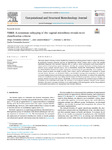Mostrar o rexistro simple do ítem
VIBES: A consensus subtyping of the vaginal microbiota reveals novel classification criteria
| dc.contributor.author | Fernández-Edreira, Diego | |
| dc.contributor.author | Liñares Blanco, Jose | |
| dc.contributor.author | Vázquez del Río, Patricia | |
| dc.contributor.author | Fernández-Lozano, Carlos | |
| dc.date.accessioned | 2024-04-25T18:27:47Z | |
| dc.date.available | 2024-04-25T18:27:47Z | |
| dc.date.issued | 2024 | |
| dc.identifier.citation | Fernández-Edreira, D., Liñares-Blanco, J., Patricia, V., & Fernandez-Lozano, C. (2024). VIBES: A consensus subtyping of the vaginal microbiota reveals novel classification criteria. Computational and Structural Biotechnology Journal, 23, 148-156. https://doi.org/10.1016/j.csbj.2023.11.050 | es_ES |
| dc.identifier.issn | 2001-0370 | |
| dc.identifier.uri | http://hdl.handle.net/2183/36357 | |
| dc.description | Availability of data and materials The bacterial 16S rRNA gene sequences from all cohorts (SRA022855, SRA051298, PRJNA208535, PRJNA797778, and PRJNA302078) can be accessed via their respective accession numbers on the ENA Browser. Code availability The source code to reproduce all the analysis, along with documentation, is available on GitHub: https://github.com/MALL-Machine-Learning-in-Live-Sciences/BV_Microbiome VIBES can be downloaded and installed directly from: https://github.com/MALL-Machine-Learning-in-Live-Sciences/VIBES | es_ES |
| dc.description.abstract | [Abstract]: This study aimed to develop a robust classification scheme for stratifying patients based on vaginal microbiome. By employing consensus clustering analysis, we identified four distinct clusters using a cohort that includes individuals diagnosed with Bacterial Vaginosis (BV) as well as control participants, each characterized by unique patterns of microbiome species abundances. Notably, the consistent distribution of these clusters was observed across multiple external cohorts, such as SRA022855, SRA051298, PRJNA208535, PRJNA797778, and PRJNA302078 obtained from public repositories, demonstrating the generalizability of our findings. We further trained an elastic net model to predict these clusters, and its performance was evaluated in various external cohorts. Moreover, we developed VIBES, a user-friendly R package that encapsulates the model for convenient implementation and enables easy predictions on new data. Remarkably, we explored the applicability of this new classification scheme in providing valuable insights into disease progression, treatment response, and potential clinical outcomes in BV patients. Specifically, we demonstrated that the combined output of VIBES and VALENCIA scores could effectively predict the response to metronidazole antibiotic treatment in BV patients. Therefore, this study's outcomes contribute to our understanding of BV heterogeneity and lay the groundwork for personalized approaches to BV management and treatment selection. | es_ES |
| dc.description.sponsorship | CITIC is funded by the Xunta de Galicia through the collaboration agreement between the Ministry of Culture, Education, Vocational Training, and Universities and the Galician universities for the strengthening of research centers in the University System of Galicia (CIGUS). The authors acknowledge the support of CESGA (Centro de Supercomputación de Galicia) for providing computing resources and related technical support that contributed to the research results reported in this paper. JLB work was financed by the Spanish Ministry of Universities by means of the Margarita Salas (RSUC.UDC.MS06) linked to the European Union through the NextGenerationEU program. | es_ES |
| dc.language.iso | eng | es_ES |
| dc.publisher | Elsevier | es_ES |
| dc.relation.uri | https://doi.org/10.1016/j.csbj.2023.11.050 | es_ES |
| dc.rights | Atribución 4.0 Internacional | es_ES |
| dc.rights.uri | http://creativecommons.org/licenses/by/3.0/es/ | * |
| dc.subject | Bacterial vaginosis | es_ES |
| dc.subject | Microbiome | es_ES |
| dc.subject | Machine learning | es_ES |
| dc.subject | Consensus clustering analysis | es_ES |
| dc.subject | Treatment response | es_ES |
| dc.title | VIBES: A consensus subtyping of the vaginal microbiota reveals novel classification criteria | es_ES |
| dc.type | journal article | es_ES |
| dc.rights.accessRights | open access | es_ES |
| UDC.journalTitle | Computational and Structural Biotechnology Journal | es_ES |
| UDC.volume | 23 | es_ES |
| UDC.startPage | 148 | es_ES |
| UDC.endPage | 156 | es_ES |
| dc.identifier.doi | 10.1016/j.csbj.2023.11.050 | |
| UDC.coleccion | Investigación | es_ES |
| UDC.departamento | Ciencias da Computación e Tecnoloxías da Información | es_ES |
| UDC.grupoInv | Laboratorio de Aprendizaxe Automático en Ciencias Vivas (MALL) | es_ES |
Ficheiros no ítem
Este ítem aparece na(s) seguinte(s) colección(s)
-
Investigación (FIC) [1654]






